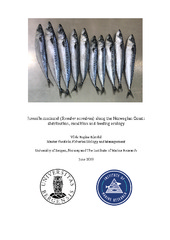| dc.description.abstract | There has been a substantial increase in the stock size of North East Atlantic (NEA) mackerel (Scomber scombrus) during the last decade (2006-2016), coinciding with record high recruitment. This situation has resulted in a pronounced northward geographical expansion of mackerel in the North Atlantic, followed by an influx of juvenile mackerel into Norwegian waters. By using both scientific survey data and opportunistically submitted observations, this thesis aims at describing the geographic distribution and the weight-at-length of ~1-year old NEA mackerel in Norwegian waters during 2017 and 2018. The diet composition of juveniles was studied from the stomachs of sampled individuals from 2018 caught during the Norwegian Spring Spawning Herring (NSSH) post-larvae survey in June and the International Ecosystem Survey in the Nordic Seas (IESSNS) in July. In 2017 and 2018 juvenile mackerel were caught between 56ºN in the North Sea to the far north of the North Cape at 73ºN, as well as in the Norwegian Sea. As far as we know, juvenile mackerel have never been observed this far north earlier in history. The juveniles were also present along the coast during all quarters of the year, from 58ºN and northwards. The mean weight-at-length for juveniles from Norwegian waters was lower during winter and summer compared with the mean weight-at-length for juveniles from traditional nursery grounds in the North Sea. The individual length and the weight-at-length also varied with season and latitude along the Norwegian coast. Juveniles caught north of 63ºN during winter were smaller and weighed significantly less than juveniles caught south in the study area, but had a significantly higher weight-at-length during the summer season than juveniles caught south of 63ºN. These results suggest that individuals caught at more northern latitudes were able to consume enough prey to recover quickly during spring and summer, even though their condition during winter was lower than juveniles from the southern latitudes along the Norwegian coast. Totally 78% of the 146 individuals sampled for dietary analysis had prey items in their stomachs (fullness degree 2-5), which confirmed that the juvenile mackerel were feeding during the summer season in Norwegian waters. Based upon the dietary analysis from individuals caught in June and July, the juvenile mackerel preyed on a wide number of prey groups and seemed to utilize both passive particulate feeding and active feeding to increase the intake of prey and be opportunistic when selecting prey. Appendicularians were the most abundant prey group, accounting for 31% of the dry stomach content weight. The copepod Calanus finmarchicus was found in approximately 1/3 of all stomachs but accounted only for 1.2% of the total dry weight. Although this was a low number considering C. finmarchicus is a preferred prey for juveniles in the nursery area, it was not unexpected as the density peak of C. finmarchicus likely was over at the time of sampling. The findings in this thesis suggest that juvenile mackerel caught along the coast originated from spawnings in the southern parts of the Norwegian Sea, along the Norwegian coast, and north of 63ºN. The opportunistic prey selection indicates that the juveniles feed on most types of available prey in the water column and are thus a potential competitor with other pelagic fish species that prey upon zooplankton, especially in coastal waters. | en_US |
